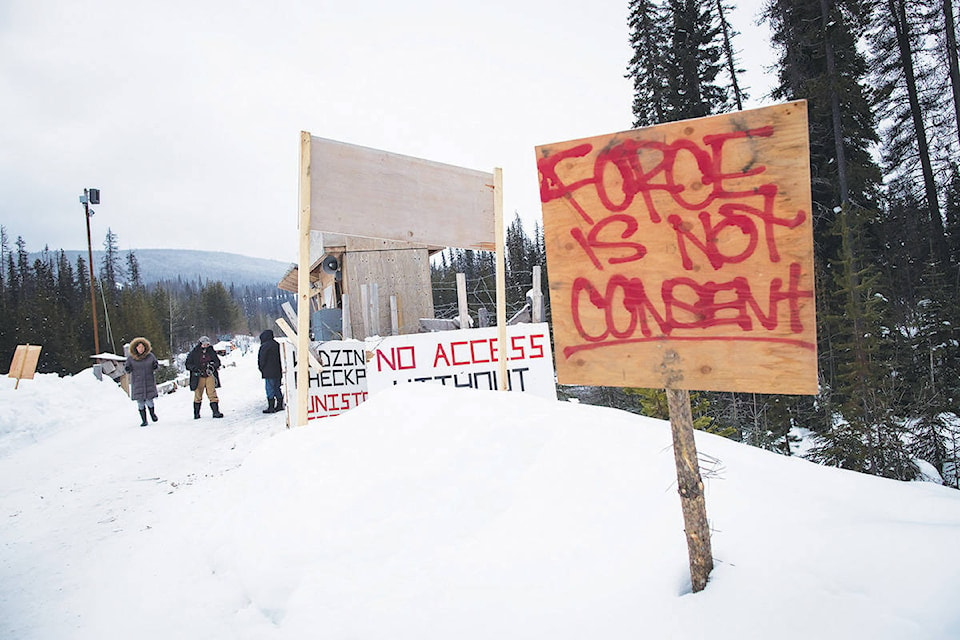Unist’ot’en camp is formally requesting the Environmental Assessment Office (EAO) continue to withhold final permits for construction of Coastal GasLink’s (CGL) 670-kilometre pipeline.
The proposed development would deliver natural gas from the Dawson Creek area to the LNG Canada facility near Kitimat, B.C.
While the Jan. 21 press release acknowledges the company did submit report to the B.C. EAO on Nov. 20, 2019 they say it was incomplete as it did not mention the Healing Centre located at Unist’ot’en camp.
The release says completion of this report was a condition of CGL’s Environmental Assessment Certificate for the portion of the project which affects Unist’ot’en territory and a portion of Gidimt’en territory.
“The report is meant to consider environmental, economic, social, heritage and health effects of the proposed project,” the release reads.
“CGL failed to include any mention of the Unist’ot’en Healing Center, the most significant economic, social and health-related institution within the study boundary, in their report.”
The release is also critical of proposed measures for mitigating environmental impacts in the event of pipeline construction polluting the nearby Wedzin Kwa (Morice) river, namely offering to deliver potable water to the healing centre.
READ MORE: Protesters block entrance to government building in support of Wet’suwet’en First Nation
“Any other wilderness lodge, tourism outfitter, or institution with economic or social interests within the pipeline footprint is required by the EAO to be considered in the contents of the report, so that potential conflicts can be mitigated.
“The Unist’ot’en Healing Center has yet to be granted the same consideration by CGL’s report.”
When The Interior News reached out for comment a spokesperson with the company said CGL has in place all major permits required to construct, including an Environmental Assessment Certificate (EAC).
They added that CGL remaind committed to ongoing dialogue and working with Dark House (Unist’ot’en) to understand their concerns wherever possible.
“The EAC was issued with a number of conditions, which have been satisfied with exception of certain work within the Morice River area as we were prevented accessing this area due to the previous blockade and we are working to satisfy the condition related to that area.”
The response also pointed to Justice Church’s Dec. 31, 2019 interlocutory injunction in which she noted CGL tried, unsuccessfully, on multiple occasions to access the areas for completion of neccessary field work.
“The plaintiff made repeated attempts to consult directly with Dark House and offered to provide information, discuss the concerns of Dark House regarding the Pipeline Project and ways to mitigate the potential impacts to Dark House territory. Dark House was invited to participate in the Environmental Assessment Office’s Working Group for the Pipeline Project but refused to do so,” said Church in her ruling.
The Interior News also reached out to the Province’s Ministry of Environment and Climate Change Strategy for comment.
In an emailed response the ministry confirmed that the report in question was submitted to the EAO by CGL as a requirement under their EAC and that meeting EAO requirements is required for CGL to proceed with construction .
“The EAO is undertaking a review of the report and whether it meets the requirements of condition 1 of the CGL project’s EAC over the next several weeks. That review process includes feedback from other parties, including the Wet’suwet’en.”
The process is part of the office’s work to ensure industry meets requirements of their environmental approval.
“CGL received their EAC in 2014 following a thorough environmental assessment process. That process involved an extensive consultation process with stakeholders and numerous Indigenous groups, including the Wet’suwet’en and Dark House.”
But those on the side of the hereditary chiefs say that the healing centre requires unimpeded access for Wet’suwet’en people to and from the territory.
“The Unist’ot’en Healing Centre was built with the assistance of settler supporters working hand in hand with us to fund and construct the infrastructure that allows us to provide self-determined culturally rooted, land-based healing programming by, and for, Indigenous Peoples,” said Clinical Director of Unist’ot’en Healing Centre and Unist’ot’en House Member Karla Tait, Ph.D.
“This vision of healing through cultural revitalization and reconnection to the land is the foundation of our land use plan, and it depends on healthy, intact land. It requires uninhibited access to our territory which contains all the relatives (aka, resources) necessary to comprehensively practice our culture including a pristine water source, plants, medicines and animals to sustain us, physically, mentally, emotionally and spiritually.”
The Unist’ot’en Healing Center is an Indigenous-owned and operated land-based health facility and wilderness lodge located in the heart of Unist’ot’en’s Talbits Kwa Territory, which is central in the dispute over the CGL Pipeline. The camp is located at the 66-kilometre mark of the Morice West Forest Service Road.
With recent investment in infrastructure in the territory valued at over $2 million and a recent $400,000 grant for operations funding from the First Nations Health Authority, the Unist’ot’en healing centre delivers year round, land-based cultural programming on site.
trevor.hewitt@interior-news.com
Like us on Facebook and follow us on Twitter
